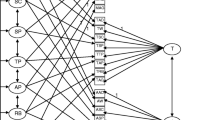Abstract
The responses of 393 parents of clinic-referred and welladjusted children to the Children's Behavior Checklist were analyzed. Of 154 items, 66 proved to discriminate between clinic and nonclinic groups. Many of these items were reflective of the general dimensions of Competence and Impulsivity yielded by an overall factor analysis. More specific patterns of factors emerged for subgroups of parents. Interparent agreement in perception was found to be a complex function of a child's age, sex, and adjustment level. The implications of the results for clinical assessment of children and families and for studies of parentchild relations are discussed.
Similar content being viewed by others
References
Alexander, J. Defensive and supportive communications in normal and deviant families.Journal of Consulting and Clinical Psychology, 1972,40, 223–231.
Anderson, L. M. Personality characteristics of parents of neurotic, aggressive and normal preadolescent boys.Journal of Consulting and Clinical Psychology, 1969,33, 575–581.
Burdock, E. I., & Hardesty, A. S. A children's behavior diagnostic inventory.Annals of the New York Academy of Sciences, 1964,105, 890–896.
Clark, A., & van Sommers, P. Contradictory demands in family relations and adjustment to school and home.Human Relations, 1961,14, 97–111.
Conners, K. Symptom patterns in hyperkinetic, neurotic, and normal children.Child Development, 1970,41, 667–683.
Cotler, J., & Shoemaker, D. J. The accuracy of mothers' reports.Journal of Genetic Psychology, 1969,114, 97–107.
Eron, L., Banta, F., Walder, L., & Laulicht, J. Comparison of data obtained from mothers and fathers on childrearing practices and their relation to child aggression.Child Development, 1961,32, 457–472.
Griffiths, W. Behavior difficulties of children as perceived and judged by parents, teachers, and children themselves.University of Minnesota Institute of Child Welfare Monograph Series XXV, Minneapolis: University of Minnesota Press, 1952.
Hollingshead, A. Two-factor index of social position. New Haven: Privately printed, 1957.
Jenkins, R. L. Psychiatric syndromes in children and their relation to family background.American Journal of Orthopsychiatry, 1966,36, 450–457.
Leighton, L. A., Stollak, G. A., & Ferguson, L. R. Patterns of communication in normal and clinic families.Journal of Consulting and Clinical Psychology, 1971,36, 252–256.
Lester, B. M. The behavior of normal and clinic referred children as perceived by their parents. Unpublished Master's thesis, Michigan State University, 1970.
Medinnus, G. Q. sort descriptions of five-year-old children by their parents.Child Development, 1961,32, 473–489.
Miller, L. Q. sort agreement among observers of children.American Journal of Orthopsychiatry, 1964,34, 71–75.
Murrell, S. A., & Stachowiak, J. G. Consistency, rigidity and power in the interaction patterns of clinic and non-clinic families.Journal of Abnormal Psychology, 1967,72, 265–272.
Partyka, L. B. The agreement between parents in perceiving the behavior of clinic and non-clinic children. Unpublished Master's thesis, Michigan State University, 1971.
Peterson, R., Becker, W., Shoemaker, D., Luria, Z., & Hellmer, L. Child behavior and parental attitudes.Child Development, 1961,32, 151–162.
Quay, H. C., & Quay, L. C. Behavior problems in early adolescence.Child Development, 1965,36, 215–220.
Ross, A. O., Lacey, H. M., & Parton, D. A. The development of a behavior checklist for boys.Child Development, 1965,36, 1013–1027.
Sears, R., Maccoby, E., & Levin, H.Patterns of child rearing. New York: Harper & Row, 1957.
Speer, D. C. Behavior Problem Checklist (Peterson-Quay): Base-line data from parents of child guidance and non-clinic children.Journal of Consulting and Clinical Psychology. 1971,36, 221–228.
Van Der Veen, F., Huebner, B., Jorgens, B., and Neja, P. Relationship between the parents' concept of the family and family adjustment.American Journal of Orthopsychiatry, 1964,34, 45–54.
Winer, B.Statistical principles in experimental design. New York: McGraw-Hill, 1962.
Author information
Authors and Affiliations
Rights and permissions
About this article
Cite this article
Ferguson, L.R., Partyka, L.B. & Lester, B.M. Patterns of parent perception differentiating clinic from nonclinic children. J Abnorm Child Psychol 2, 169–181 (1974). https://doi.org/10.1007/BF00918885
Revised:
Issue Date:
DOI: https://doi.org/10.1007/BF00918885




